Analyzing Management and Leadership Roles in Vodafone: A Case Study
VerifiedAdded on 2023/06/03
|11
|2266
|273
Essay
AI Summary
This essay analyzes the distinct roles and responsibilities of managers and leaders within Vodafone, highlighting their influence on organizational policies and procedures, particularly during crises. It differentiates between management and leadership, supported by relevant theories to emphasize their importance in ensuring smooth operations. The discussion incorporates leadership and management theories, concluding with the application of 'chaos theory' and 'management by objectives' to provide a comprehensive understanding of Vodafone's operational strategies and approaches to overcoming challenges. Desklib offers a wealth of similar resources for students.

Running head: MANAGEMENT AND LEADERSHIP IN VODAFONE
MANAGEMENT AND LEADERSHIP IN VODAFONE
Name of the student:
Name of the University:
Author's Note:
MANAGEMENT AND LEADERSHIP IN VODAFONE
Name of the student:
Name of the University:
Author's Note:
Paraphrase This Document
Need a fresh take? Get an instant paraphrase of this document with our AI Paraphraser

1MANAGEMENT AND LEADERSHIP IN VODAFONE
Executive summary
This essay will be analysis the roles and accountabilities of leaders and managers as they are two
most important factors in the organization. The roles and responsibilities of the managers as well
as leaders are similar to influence the policies and procedures of the firms. This report has
discussed the differences of responsibilities of these two aspects and how they react in the crisis
situation. This report has supported the discussion by leadership and management theories so that
their importance in smooth running of the organization can be understood. This report has
concluded with ‘chaos theory’ and ‘management by objectives’ to understand the operation of
the company.
Executive summary
This essay will be analysis the roles and accountabilities of leaders and managers as they are two
most important factors in the organization. The roles and responsibilities of the managers as well
as leaders are similar to influence the policies and procedures of the firms. This report has
discussed the differences of responsibilities of these two aspects and how they react in the crisis
situation. This report has supported the discussion by leadership and management theories so that
their importance in smooth running of the organization can be understood. This report has
concluded with ‘chaos theory’ and ‘management by objectives’ to understand the operation of
the company.
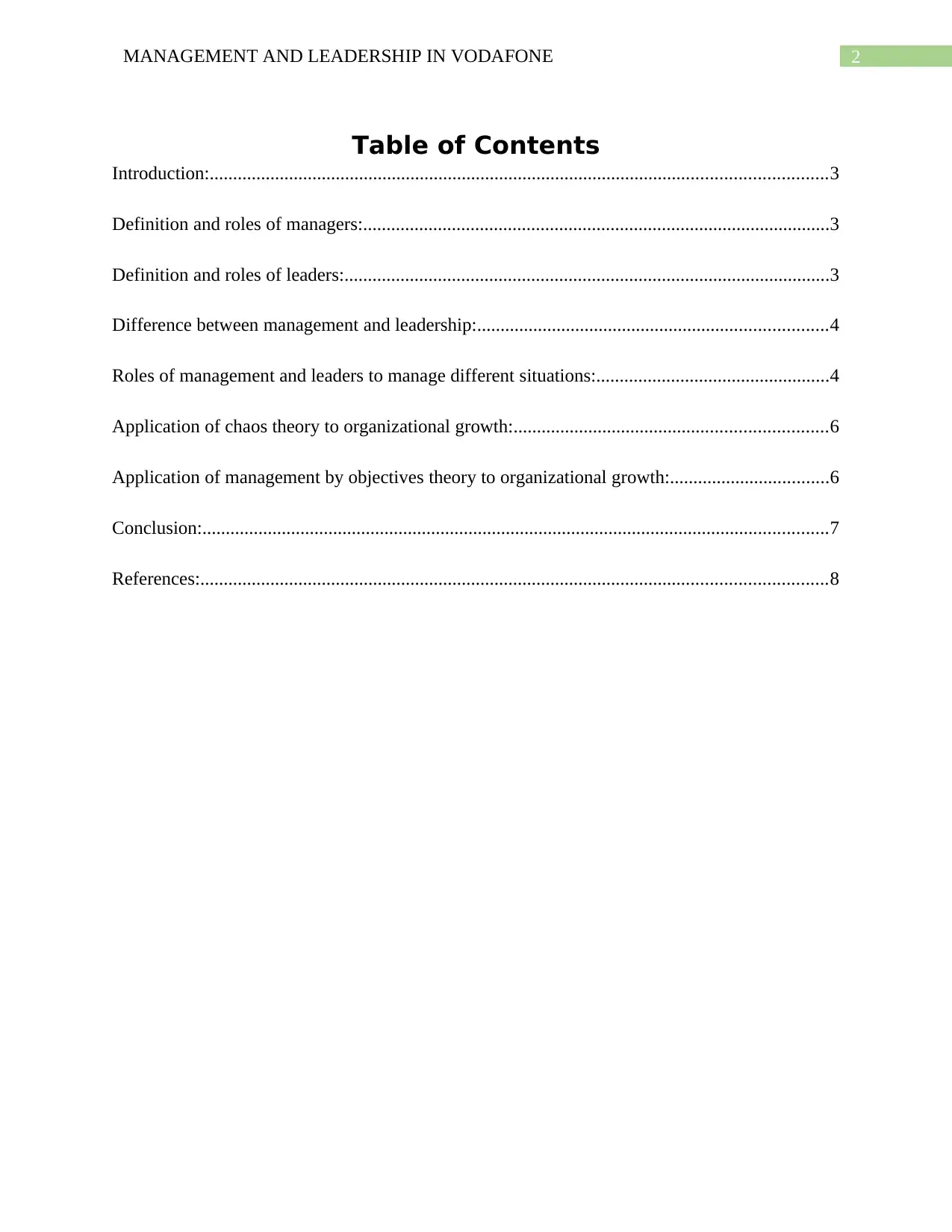
2MANAGEMENT AND LEADERSHIP IN VODAFONE
Table of Contents
Introduction:....................................................................................................................................3
Definition and roles of managers:....................................................................................................3
Definition and roles of leaders:........................................................................................................3
Difference between management and leadership:...........................................................................4
Roles of management and leaders to manage different situations:..................................................4
Application of chaos theory to organizational growth:...................................................................6
Application of management by objectives theory to organizational growth:..................................6
Conclusion:......................................................................................................................................7
References:......................................................................................................................................8
Table of Contents
Introduction:....................................................................................................................................3
Definition and roles of managers:....................................................................................................3
Definition and roles of leaders:........................................................................................................3
Difference between management and leadership:...........................................................................4
Roles of management and leaders to manage different situations:..................................................4
Application of chaos theory to organizational growth:...................................................................6
Application of management by objectives theory to organizational growth:..................................6
Conclusion:......................................................................................................................................7
References:......................................................................................................................................8
⊘ This is a preview!⊘
Do you want full access?
Subscribe today to unlock all pages.

Trusted by 1+ million students worldwide
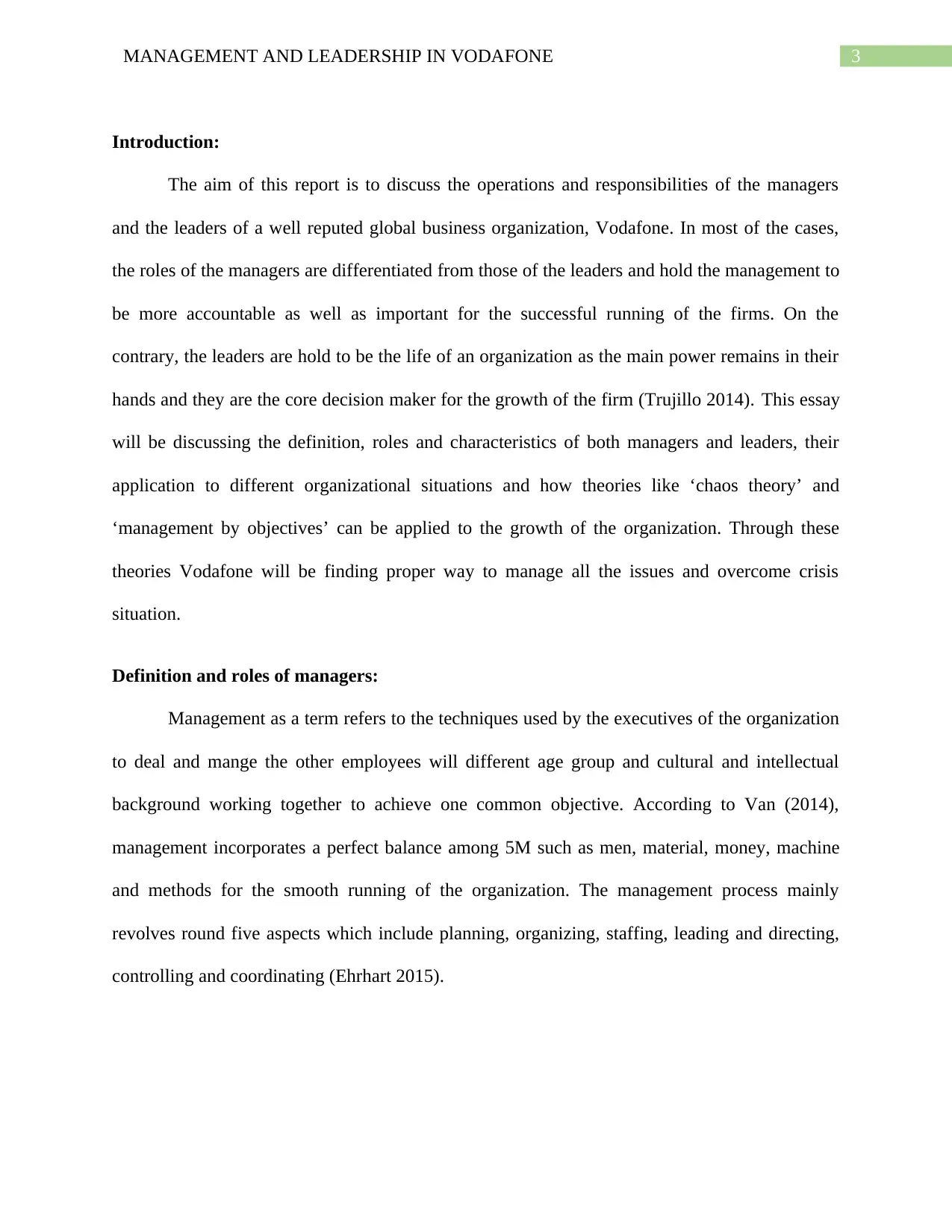
3MANAGEMENT AND LEADERSHIP IN VODAFONE
Introduction:
The aim of this report is to discuss the operations and responsibilities of the managers
and the leaders of a well reputed global business organization, Vodafone. In most of the cases,
the roles of the managers are differentiated from those of the leaders and hold the management to
be more accountable as well as important for the successful running of the firms. On the
contrary, the leaders are hold to be the life of an organization as the main power remains in their
hands and they are the core decision maker for the growth of the firm (Trujillo 2014). This essay
will be discussing the definition, roles and characteristics of both managers and leaders, their
application to different organizational situations and how theories like ‘chaos theory’ and
‘management by objectives’ can be applied to the growth of the organization. Through these
theories Vodafone will be finding proper way to manage all the issues and overcome crisis
situation.
Definition and roles of managers:
Management as a term refers to the techniques used by the executives of the organization
to deal and mange the other employees will different age group and cultural and intellectual
background working together to achieve one common objective. According to Van (2014),
management incorporates a perfect balance among 5M such as men, material, money, machine
and methods for the smooth running of the organization. The management process mainly
revolves round five aspects which include planning, organizing, staffing, leading and directing,
controlling and coordinating (Ehrhart 2015).
Introduction:
The aim of this report is to discuss the operations and responsibilities of the managers
and the leaders of a well reputed global business organization, Vodafone. In most of the cases,
the roles of the managers are differentiated from those of the leaders and hold the management to
be more accountable as well as important for the successful running of the firms. On the
contrary, the leaders are hold to be the life of an organization as the main power remains in their
hands and they are the core decision maker for the growth of the firm (Trujillo 2014). This essay
will be discussing the definition, roles and characteristics of both managers and leaders, their
application to different organizational situations and how theories like ‘chaos theory’ and
‘management by objectives’ can be applied to the growth of the organization. Through these
theories Vodafone will be finding proper way to manage all the issues and overcome crisis
situation.
Definition and roles of managers:
Management as a term refers to the techniques used by the executives of the organization
to deal and mange the other employees will different age group and cultural and intellectual
background working together to achieve one common objective. According to Van (2014),
management incorporates a perfect balance among 5M such as men, material, money, machine
and methods for the smooth running of the organization. The management process mainly
revolves round five aspects which include planning, organizing, staffing, leading and directing,
controlling and coordinating (Ehrhart 2015).
Paraphrase This Document
Need a fresh take? Get an instant paraphrase of this document with our AI Paraphraser
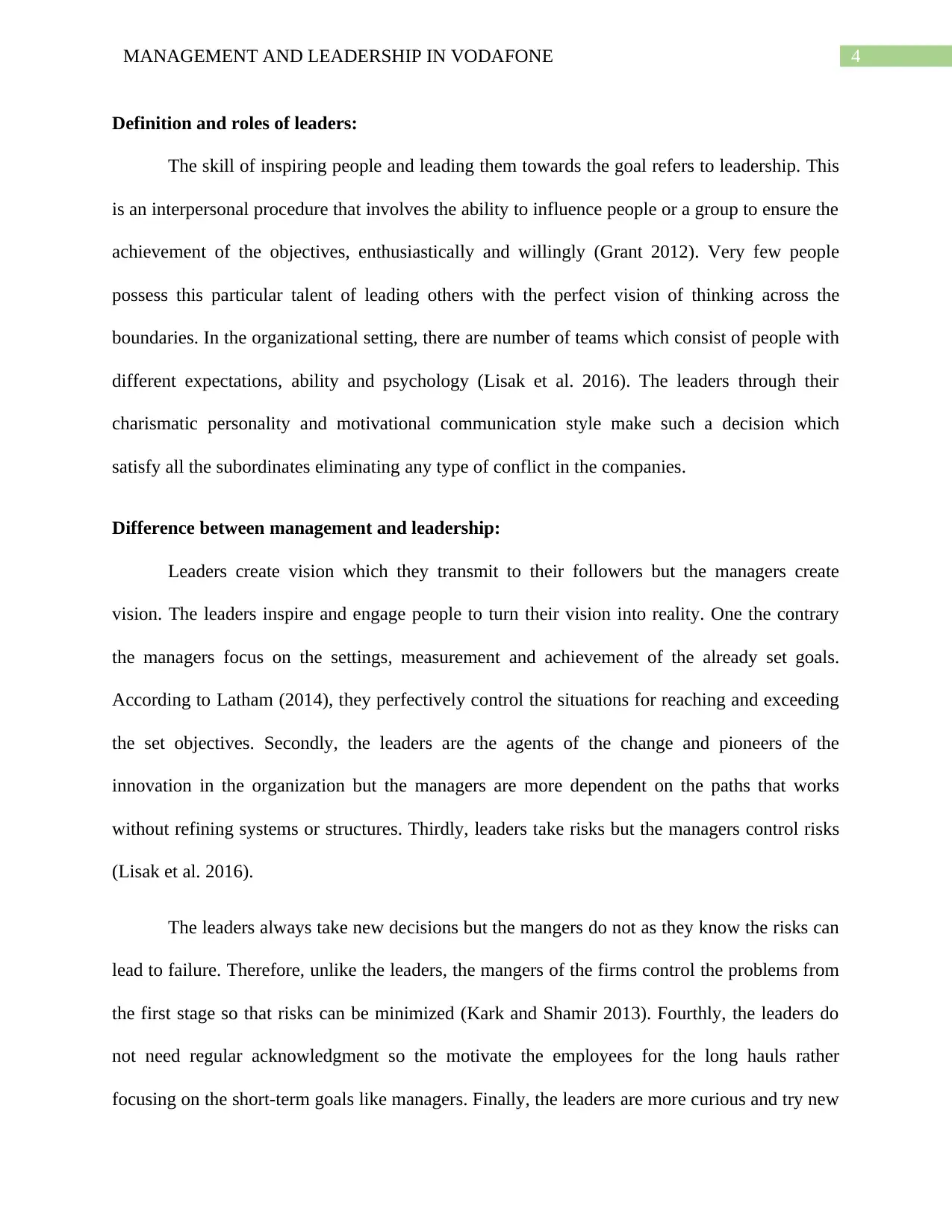
4MANAGEMENT AND LEADERSHIP IN VODAFONE
Definition and roles of leaders:
The skill of inspiring people and leading them towards the goal refers to leadership. This
is an interpersonal procedure that involves the ability to influence people or a group to ensure the
achievement of the objectives, enthusiastically and willingly (Grant 2012). Very few people
possess this particular talent of leading others with the perfect vision of thinking across the
boundaries. In the organizational setting, there are number of teams which consist of people with
different expectations, ability and psychology (Lisak et al. 2016). The leaders through their
charismatic personality and motivational communication style make such a decision which
satisfy all the subordinates eliminating any type of conflict in the companies.
Difference between management and leadership:
Leaders create vision which they transmit to their followers but the managers create
vision. The leaders inspire and engage people to turn their vision into reality. One the contrary
the managers focus on the settings, measurement and achievement of the already set goals.
According to Latham (2014), they perfectively control the situations for reaching and exceeding
the set objectives. Secondly, the leaders are the agents of the change and pioneers of the
innovation in the organization but the managers are more dependent on the paths that works
without refining systems or structures. Thirdly, leaders take risks but the managers control risks
(Lisak et al. 2016).
The leaders always take new decisions but the mangers do not as they know the risks can
lead to failure. Therefore, unlike the leaders, the mangers of the firms control the problems from
the first stage so that risks can be minimized (Kark and Shamir 2013). Fourthly, the leaders do
not need regular acknowledgment so the motivate the employees for the long hauls rather
focusing on the short-term goals like managers. Finally, the leaders are more curious and try new
Definition and roles of leaders:
The skill of inspiring people and leading them towards the goal refers to leadership. This
is an interpersonal procedure that involves the ability to influence people or a group to ensure the
achievement of the objectives, enthusiastically and willingly (Grant 2012). Very few people
possess this particular talent of leading others with the perfect vision of thinking across the
boundaries. In the organizational setting, there are number of teams which consist of people with
different expectations, ability and psychology (Lisak et al. 2016). The leaders through their
charismatic personality and motivational communication style make such a decision which
satisfy all the subordinates eliminating any type of conflict in the companies.
Difference between management and leadership:
Leaders create vision which they transmit to their followers but the managers create
vision. The leaders inspire and engage people to turn their vision into reality. One the contrary
the managers focus on the settings, measurement and achievement of the already set goals.
According to Latham (2014), they perfectively control the situations for reaching and exceeding
the set objectives. Secondly, the leaders are the agents of the change and pioneers of the
innovation in the organization but the managers are more dependent on the paths that works
without refining systems or structures. Thirdly, leaders take risks but the managers control risks
(Lisak et al. 2016).
The leaders always take new decisions but the mangers do not as they know the risks can
lead to failure. Therefore, unlike the leaders, the mangers of the firms control the problems from
the first stage so that risks can be minimized (Kark and Shamir 2013). Fourthly, the leaders do
not need regular acknowledgment so the motivate the employees for the long hauls rather
focusing on the short-term goals like managers. Finally, the leaders are more curious and try new
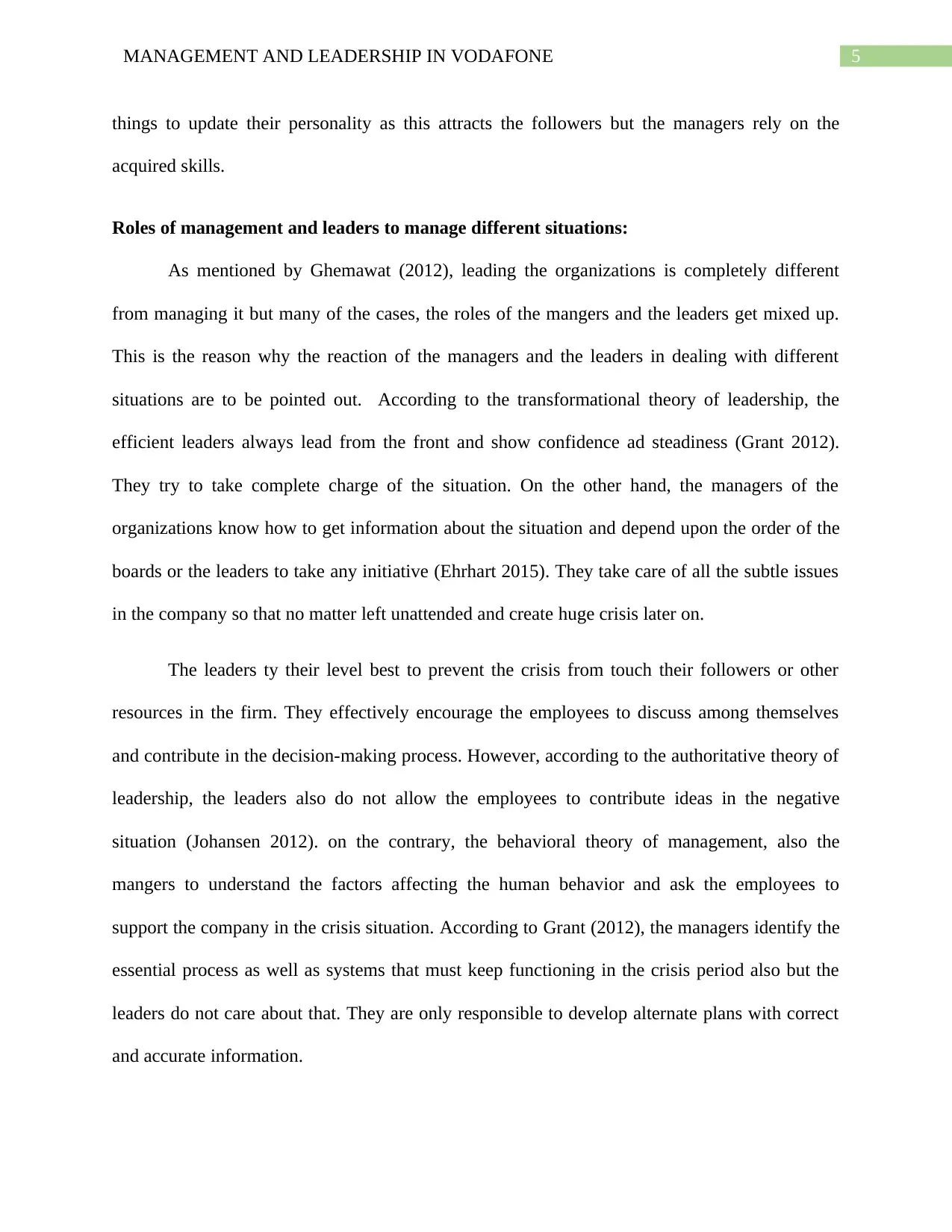
5MANAGEMENT AND LEADERSHIP IN VODAFONE
things to update their personality as this attracts the followers but the managers rely on the
acquired skills.
Roles of management and leaders to manage different situations:
As mentioned by Ghemawat (2012), leading the organizations is completely different
from managing it but many of the cases, the roles of the mangers and the leaders get mixed up.
This is the reason why the reaction of the managers and the leaders in dealing with different
situations are to be pointed out. According to the transformational theory of leadership, the
efficient leaders always lead from the front and show confidence ad steadiness (Grant 2012).
They try to take complete charge of the situation. On the other hand, the managers of the
organizations know how to get information about the situation and depend upon the order of the
boards or the leaders to take any initiative (Ehrhart 2015). They take care of all the subtle issues
in the company so that no matter left unattended and create huge crisis later on.
The leaders ty their level best to prevent the crisis from touch their followers or other
resources in the firm. They effectively encourage the employees to discuss among themselves
and contribute in the decision-making process. However, according to the authoritative theory of
leadership, the leaders also do not allow the employees to contribute ideas in the negative
situation (Johansen 2012). on the contrary, the behavioral theory of management, also the
mangers to understand the factors affecting the human behavior and ask the employees to
support the company in the crisis situation. According to Grant (2012), the managers identify the
essential process as well as systems that must keep functioning in the crisis period also but the
leaders do not care about that. They are only responsible to develop alternate plans with correct
and accurate information.
things to update their personality as this attracts the followers but the managers rely on the
acquired skills.
Roles of management and leaders to manage different situations:
As mentioned by Ghemawat (2012), leading the organizations is completely different
from managing it but many of the cases, the roles of the mangers and the leaders get mixed up.
This is the reason why the reaction of the managers and the leaders in dealing with different
situations are to be pointed out. According to the transformational theory of leadership, the
efficient leaders always lead from the front and show confidence ad steadiness (Grant 2012).
They try to take complete charge of the situation. On the other hand, the managers of the
organizations know how to get information about the situation and depend upon the order of the
boards or the leaders to take any initiative (Ehrhart 2015). They take care of all the subtle issues
in the company so that no matter left unattended and create huge crisis later on.
The leaders ty their level best to prevent the crisis from touch their followers or other
resources in the firm. They effectively encourage the employees to discuss among themselves
and contribute in the decision-making process. However, according to the authoritative theory of
leadership, the leaders also do not allow the employees to contribute ideas in the negative
situation (Johansen 2012). on the contrary, the behavioral theory of management, also the
mangers to understand the factors affecting the human behavior and ask the employees to
support the company in the crisis situation. According to Grant (2012), the managers identify the
essential process as well as systems that must keep functioning in the crisis period also but the
leaders do not care about that. They are only responsible to develop alternate plans with correct
and accurate information.
⊘ This is a preview!⊘
Do you want full access?
Subscribe today to unlock all pages.

Trusted by 1+ million students worldwide
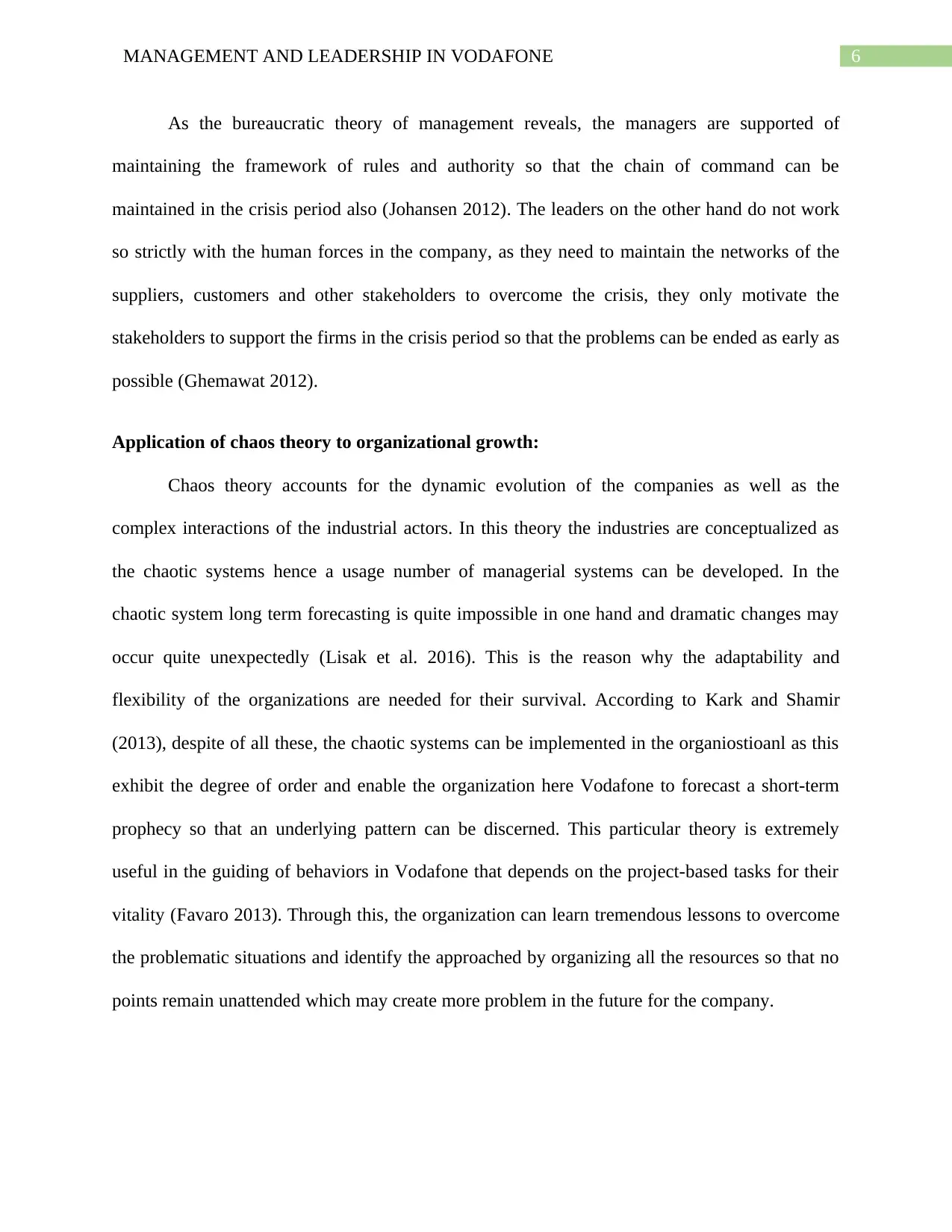
6MANAGEMENT AND LEADERSHIP IN VODAFONE
As the bureaucratic theory of management reveals, the managers are supported of
maintaining the framework of rules and authority so that the chain of command can be
maintained in the crisis period also (Johansen 2012). The leaders on the other hand do not work
so strictly with the human forces in the company, as they need to maintain the networks of the
suppliers, customers and other stakeholders to overcome the crisis, they only motivate the
stakeholders to support the firms in the crisis period so that the problems can be ended as early as
possible (Ghemawat 2012).
Application of chaos theory to organizational growth:
Chaos theory accounts for the dynamic evolution of the companies as well as the
complex interactions of the industrial actors. In this theory the industries are conceptualized as
the chaotic systems hence a usage number of managerial systems can be developed. In the
chaotic system long term forecasting is quite impossible in one hand and dramatic changes may
occur quite unexpectedly (Lisak et al. 2016). This is the reason why the adaptability and
flexibility of the organizations are needed for their survival. According to Kark and Shamir
(2013), despite of all these, the chaotic systems can be implemented in the organiostioanl as this
exhibit the degree of order and enable the organization here Vodafone to forecast a short-term
prophecy so that an underlying pattern can be discerned. This particular theory is extremely
useful in the guiding of behaviors in Vodafone that depends on the project-based tasks for their
vitality (Favaro 2013). Through this, the organization can learn tremendous lessons to overcome
the problematic situations and identify the approached by organizing all the resources so that no
points remain unattended which may create more problem in the future for the company.
As the bureaucratic theory of management reveals, the managers are supported of
maintaining the framework of rules and authority so that the chain of command can be
maintained in the crisis period also (Johansen 2012). The leaders on the other hand do not work
so strictly with the human forces in the company, as they need to maintain the networks of the
suppliers, customers and other stakeholders to overcome the crisis, they only motivate the
stakeholders to support the firms in the crisis period so that the problems can be ended as early as
possible (Ghemawat 2012).
Application of chaos theory to organizational growth:
Chaos theory accounts for the dynamic evolution of the companies as well as the
complex interactions of the industrial actors. In this theory the industries are conceptualized as
the chaotic systems hence a usage number of managerial systems can be developed. In the
chaotic system long term forecasting is quite impossible in one hand and dramatic changes may
occur quite unexpectedly (Lisak et al. 2016). This is the reason why the adaptability and
flexibility of the organizations are needed for their survival. According to Kark and Shamir
(2013), despite of all these, the chaotic systems can be implemented in the organiostioanl as this
exhibit the degree of order and enable the organization here Vodafone to forecast a short-term
prophecy so that an underlying pattern can be discerned. This particular theory is extremely
useful in the guiding of behaviors in Vodafone that depends on the project-based tasks for their
vitality (Favaro 2013). Through this, the organization can learn tremendous lessons to overcome
the problematic situations and identify the approached by organizing all the resources so that no
points remain unattended which may create more problem in the future for the company.
Paraphrase This Document
Need a fresh take? Get an instant paraphrase of this document with our AI Paraphraser
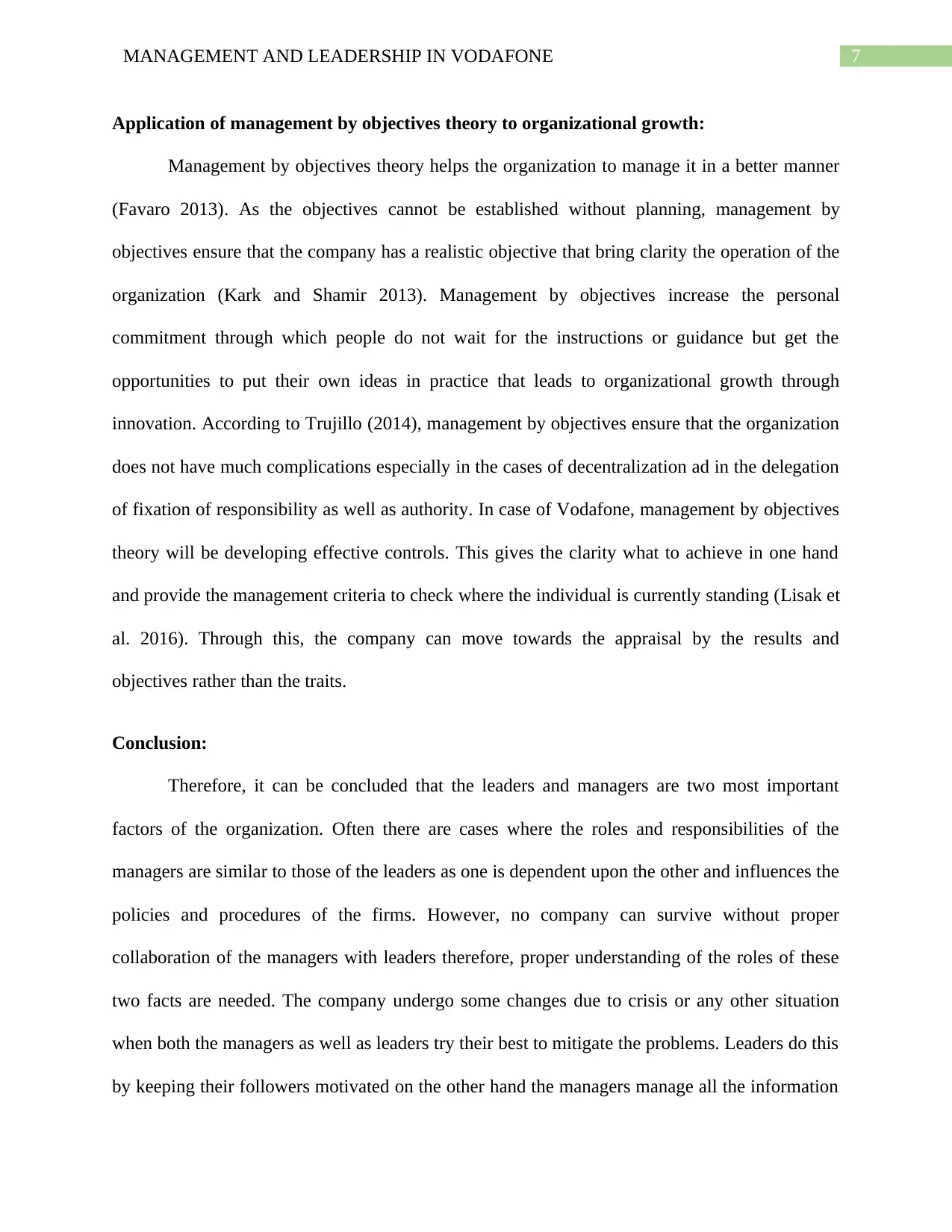
7MANAGEMENT AND LEADERSHIP IN VODAFONE
Application of management by objectives theory to organizational growth:
Management by objectives theory helps the organization to manage it in a better manner
(Favaro 2013). As the objectives cannot be established without planning, management by
objectives ensure that the company has a realistic objective that bring clarity the operation of the
organization (Kark and Shamir 2013). Management by objectives increase the personal
commitment through which people do not wait for the instructions or guidance but get the
opportunities to put their own ideas in practice that leads to organizational growth through
innovation. According to Trujillo (2014), management by objectives ensure that the organization
does not have much complications especially in the cases of decentralization ad in the delegation
of fixation of responsibility as well as authority. In case of Vodafone, management by objectives
theory will be developing effective controls. This gives the clarity what to achieve in one hand
and provide the management criteria to check where the individual is currently standing (Lisak et
al. 2016). Through this, the company can move towards the appraisal by the results and
objectives rather than the traits.
Conclusion:
Therefore, it can be concluded that the leaders and managers are two most important
factors of the organization. Often there are cases where the roles and responsibilities of the
managers are similar to those of the leaders as one is dependent upon the other and influences the
policies and procedures of the firms. However, no company can survive without proper
collaboration of the managers with leaders therefore, proper understanding of the roles of these
two facts are needed. The company undergo some changes due to crisis or any other situation
when both the managers as well as leaders try their best to mitigate the problems. Leaders do this
by keeping their followers motivated on the other hand the managers manage all the information
Application of management by objectives theory to organizational growth:
Management by objectives theory helps the organization to manage it in a better manner
(Favaro 2013). As the objectives cannot be established without planning, management by
objectives ensure that the company has a realistic objective that bring clarity the operation of the
organization (Kark and Shamir 2013). Management by objectives increase the personal
commitment through which people do not wait for the instructions or guidance but get the
opportunities to put their own ideas in practice that leads to organizational growth through
innovation. According to Trujillo (2014), management by objectives ensure that the organization
does not have much complications especially in the cases of decentralization ad in the delegation
of fixation of responsibility as well as authority. In case of Vodafone, management by objectives
theory will be developing effective controls. This gives the clarity what to achieve in one hand
and provide the management criteria to check where the individual is currently standing (Lisak et
al. 2016). Through this, the company can move towards the appraisal by the results and
objectives rather than the traits.
Conclusion:
Therefore, it can be concluded that the leaders and managers are two most important
factors of the organization. Often there are cases where the roles and responsibilities of the
managers are similar to those of the leaders as one is dependent upon the other and influences the
policies and procedures of the firms. However, no company can survive without proper
collaboration of the managers with leaders therefore, proper understanding of the roles of these
two facts are needed. The company undergo some changes due to crisis or any other situation
when both the managers as well as leaders try their best to mitigate the problems. Leaders do this
by keeping their followers motivated on the other hand the managers manage all the information
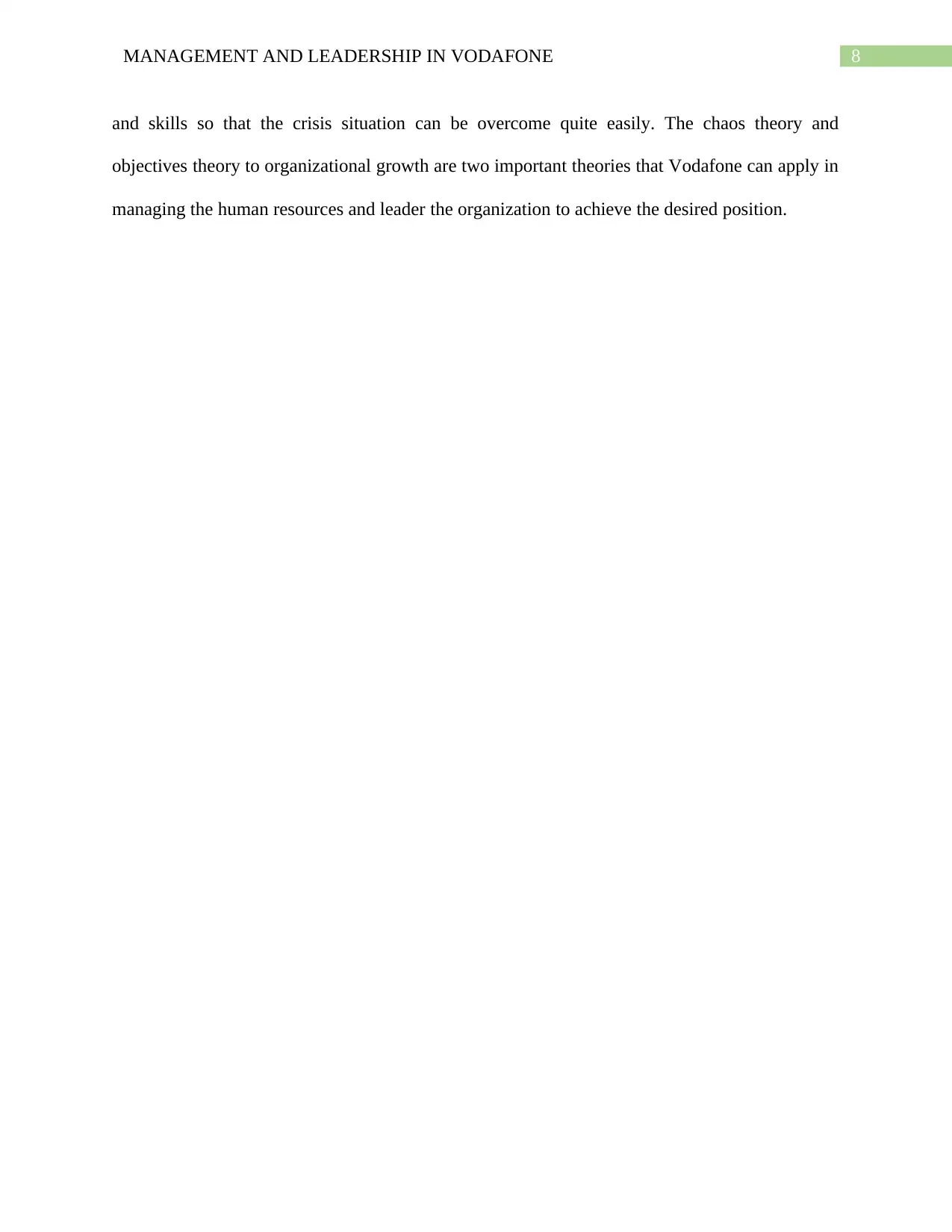
8MANAGEMENT AND LEADERSHIP IN VODAFONE
and skills so that the crisis situation can be overcome quite easily. The chaos theory and
objectives theory to organizational growth are two important theories that Vodafone can apply in
managing the human resources and leader the organization to achieve the desired position.
and skills so that the crisis situation can be overcome quite easily. The chaos theory and
objectives theory to organizational growth are two important theories that Vodafone can apply in
managing the human resources and leader the organization to achieve the desired position.
⊘ This is a preview!⊘
Do you want full access?
Subscribe today to unlock all pages.

Trusted by 1+ million students worldwide
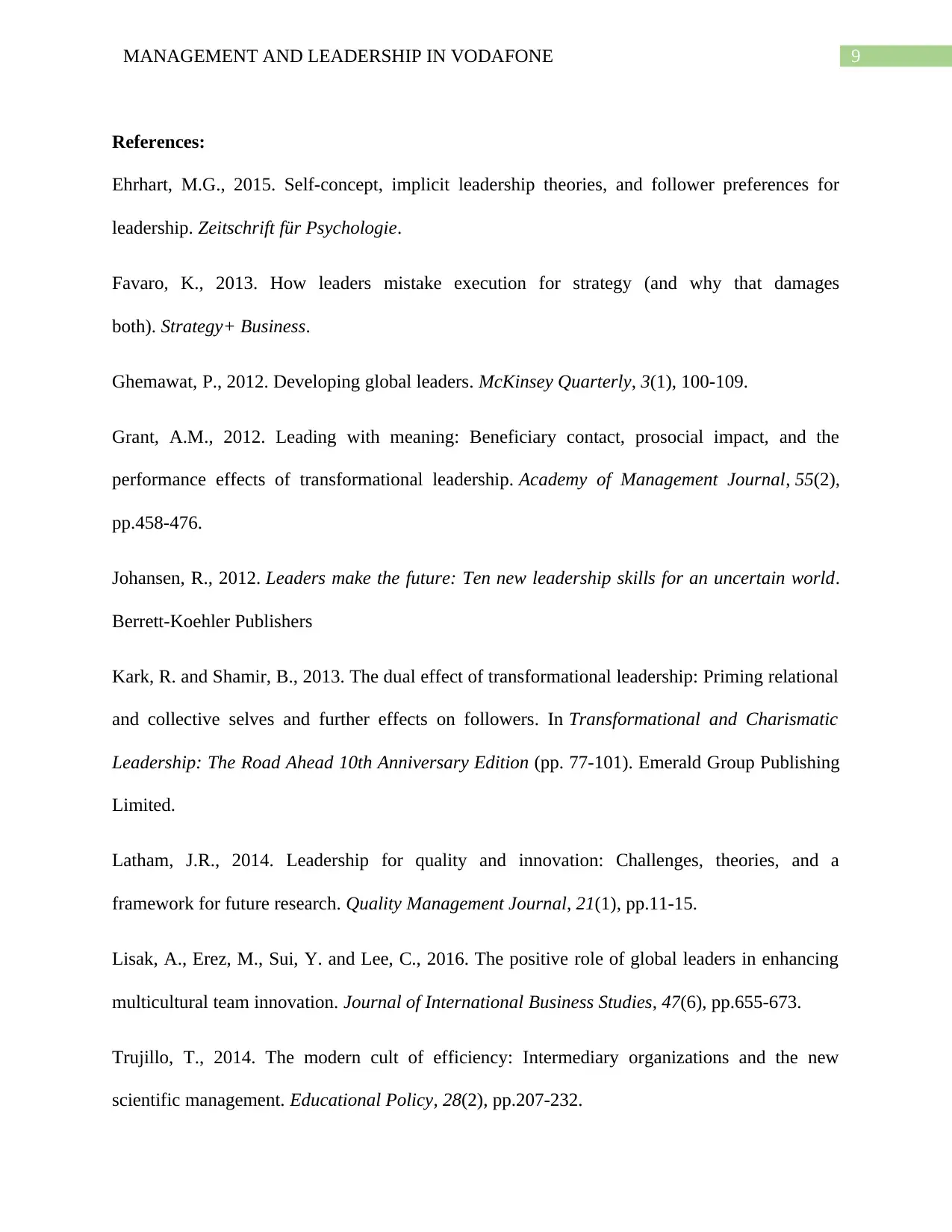
9MANAGEMENT AND LEADERSHIP IN VODAFONE
References:
Ehrhart, M.G., 2015. Self-concept, implicit leadership theories, and follower preferences for
leadership. Zeitschrift für Psychologie.
Favaro, K., 2013. How leaders mistake execution for strategy (and why that damages
both). Strategy+ Business.
Ghemawat, P., 2012. Developing global leaders. McKinsey Quarterly, 3(1), 100-109.
Grant, A.M., 2012. Leading with meaning: Beneficiary contact, prosocial impact, and the
performance effects of transformational leadership. Academy of Management Journal, 55(2),
pp.458-476.
Johansen, R., 2012. Leaders make the future: Ten new leadership skills for an uncertain world.
Berrett-Koehler Publishers
Kark, R. and Shamir, B., 2013. The dual effect of transformational leadership: Priming relational
and collective selves and further effects on followers. In Transformational and Charismatic
Leadership: The Road Ahead 10th Anniversary Edition (pp. 77-101). Emerald Group Publishing
Limited.
Latham, J.R., 2014. Leadership for quality and innovation: Challenges, theories, and a
framework for future research. Quality Management Journal, 21(1), pp.11-15.
Lisak, A., Erez, M., Sui, Y. and Lee, C., 2016. The positive role of global leaders in enhancing
multicultural team innovation. Journal of International Business Studies, 47(6), pp.655-673.
Trujillo, T., 2014. The modern cult of efficiency: Intermediary organizations and the new
scientific management. Educational Policy, 28(2), pp.207-232.
References:
Ehrhart, M.G., 2015. Self-concept, implicit leadership theories, and follower preferences for
leadership. Zeitschrift für Psychologie.
Favaro, K., 2013. How leaders mistake execution for strategy (and why that damages
both). Strategy+ Business.
Ghemawat, P., 2012. Developing global leaders. McKinsey Quarterly, 3(1), 100-109.
Grant, A.M., 2012. Leading with meaning: Beneficiary contact, prosocial impact, and the
performance effects of transformational leadership. Academy of Management Journal, 55(2),
pp.458-476.
Johansen, R., 2012. Leaders make the future: Ten new leadership skills for an uncertain world.
Berrett-Koehler Publishers
Kark, R. and Shamir, B., 2013. The dual effect of transformational leadership: Priming relational
and collective selves and further effects on followers. In Transformational and Charismatic
Leadership: The Road Ahead 10th Anniversary Edition (pp. 77-101). Emerald Group Publishing
Limited.
Latham, J.R., 2014. Leadership for quality and innovation: Challenges, theories, and a
framework for future research. Quality Management Journal, 21(1), pp.11-15.
Lisak, A., Erez, M., Sui, Y. and Lee, C., 2016. The positive role of global leaders in enhancing
multicultural team innovation. Journal of International Business Studies, 47(6), pp.655-673.
Trujillo, T., 2014. The modern cult of efficiency: Intermediary organizations and the new
scientific management. Educational Policy, 28(2), pp.207-232.
Paraphrase This Document
Need a fresh take? Get an instant paraphrase of this document with our AI Paraphraser

10MANAGEMENT AND LEADERSHIP IN VODAFONE
Van der Voet, J., 2014. The effectiveness and specificity of change management in a public
organization: Transformational leadership and a bureaucratic organizational structure. European
Management Journal, 32(3), pp.373-382.
Van der Voet, J., 2014. The effectiveness and specificity of change management in a public
organization: Transformational leadership and a bureaucratic organizational structure. European
Management Journal, 32(3), pp.373-382.
1 out of 11
Related Documents
Your All-in-One AI-Powered Toolkit for Academic Success.
+13062052269
info@desklib.com
Available 24*7 on WhatsApp / Email
![[object Object]](/_next/static/media/star-bottom.7253800d.svg)
Unlock your academic potential
Copyright © 2020–2025 A2Z Services. All Rights Reserved. Developed and managed by ZUCOL.




